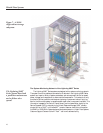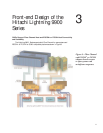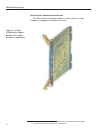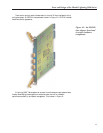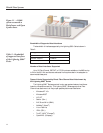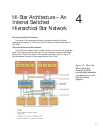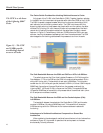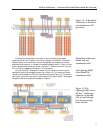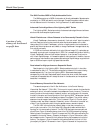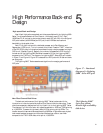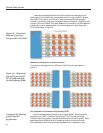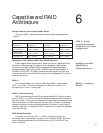
The 9960 Provides 32GB of Fully Addressable Cache
The 9960 supports up to 32GB of data cache, all directly addressable. Separate cache
modules (up to 1.5GB) are used for control storage. Competitive systems use their cache
for both data and control information, limiting the amount of usable data cache.
Advanced Cache Algorithms of the Lightning 9900
™
Series
The Lightning 9900
™
Series has a variety of advanced cache algorithms and software
solutions that allow exceptional performance.
Hitachi FlashAccess
™
Allows Datasets to be Permanently Placed in Cache
Hitachi FlashAccess
™
allows users to dynamically “lock and unlock” data into cache in
real time. Read and write functions are then performed at cache speeds, with no disk
latency delay. With Hitachi FlashAccess
™
, a portion of cache memory can be allocated to
specific data. Administrators can add, delete, or change FlashAccess
™
managed data at any
time, quickly and easily.
In S/390
®
environments, defined by the Logical Volume Image (LVI), cache data can
be as small as a single track or as large as a full 3390. For increased configuration flexibility,
Hitachi FlashAccess
™
offers multiple modes of operation. It can be used in conjunction
with Hitachi RapidXchange
™
to increase the speed of data transfer and, therefore, improve
performance of mainframes to open systems data exchange. RapidXchange
™
supports both
open-to-S/390 and open-to-open high speed data transfers.
Read-ahead for High-performance Sequential Reads
Read clustering in the Lightning 9900
™
Series is enabled using built-in heuristics
to read ahead for every I/O. The heuristics are applied to determine if the data is being
accessed sequentially. If so, then the Lightning 9900
™
Series reads ahead pages
corresponding to that data. Read-ahead helps to ensure that when a client read request
is received the requested data will already be stored in the data cache, so the request can
be satisfied immediately.
Control Memory Hierarchical Star Network
®
The second component of the Hi-Star Architecture
™
is the Control Memory
Hierarchical Star Network
™
(CM-HSN). This is a point-to-point network that handles the
exchange of control information between the processors and control memory. The control
memory contains information about the status, location, and configuration of the cache,
the data in the cache, and the configuration of the Lightning 9900
™
Series system (as well
as other information related to the operational state of the system). Two control memory
areas are mirrored images of each other. This is illustrated in Figure 16. Control data is
“data about data” also called “meta-data.” Essentially, control information is handled “out
of band” from the data paths, both through a separate memory area and network.
The CM-HSN is a much simpler network design in that every connection is a
point-to-point connection. Only the Cache-HSN (data paths) uses a switched-fabric
topology for its interconnecting network. The CM-HSN also uses a narrower path and
more of them. Figure 16 shows a close-up view of the CM-HSN’s networking topology.
Referring back to the diagram in Figure 2, there are two CM-HSN paths connecting the
processors to the control memory. However, the diagram in Figure 15 shows four paths
per processor module. There are 64 4-bit paths connecting the processors to the control
memory. The diagram in Figure 2 shows the 4-bit paths combined into their full 8-bit
(plus a parity bit) paths. The zoomed-in view in Figure 16 shows all of the ports to the
A portion of cache
memory can be allocated
to specific data.
Hitachi Data Systems
18



